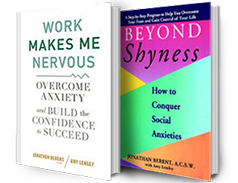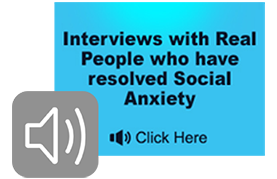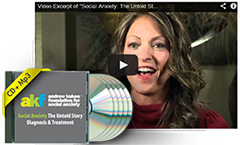The content in this article will take you past the absurd hype and mis-information that is abundant regarding social anxiety into the beginning of a realistic and productive understanding of the problem! I promise; if the subject of social anxiety is important to you, you will not be bored!
At the end of this article is The Andrew Kukes Story. Read carefully and you can access one of the most important programs for healing for free to the general public, and for continuing education credits for mental health professionals.
To begin; it’s important that you know about my background. After all, if you are going to take advice it’s important to know the quality of the source.
Here’s the short story. In 1976, fresh out of graduate school I was working in a community center as a youth worker. An associate suggested that we start a socialization group for teenagers with learning disabilities. I had no idea what she was talking about, but after doing research I discovered there was no such program. I set up a protocol where the first step was to interview applicants with a parent. Then an interesting phenomenon happened. Many of those interviewed never showed up for the group. This was my discovery of social anxiety in 1976, way before the term became commonly used.
Since this time, I have worked directly with, or supervised treatment for, approximately 10,000 individuals of all ages with social anxiety and related challenges. I have seen everything from a total “cure” (and I don’t use this term lightly) to the problem being permanent, and everything in between. It’s very unlikely that you could tell me anything I have not heard!
The degree of resolution to social anxiety depends on one’s learning curve. Treatment requires an active learning process. It is important to “quarterback” or “pilot” the learning process. Productivity cannot be achieved from a passive or defensive position. This reality upsets and confuses many sufferers, who have unrealistic expectations regarding the healing process.
An example of a common unrealistic expectation is the social anxiety sufferer who has a long term history (let’s say 20 years plus) with substantial anticipatory anxiety, intense obsessive worry, the potential for panic in the challenge scenario, and an avoidant personality and lifestyle who wants to get better in a handful of sessions. I say to this type of individual “maybe if you are a superstar like Michael Jordan (metaphorically speaking). When patients ask me “how long will therapy take?” my response is to clarify therapeutic objectives and teach the variables of the learning curve. Concurrent to this I often respond with the question “how fast can you run?”
It’s often a good idea for the person who is contemplating therapy to start with books and self-help programs to determine if the understand and buy into the concepts and strategies that are presented.
At the beginning of treatment it is very useful to have patients complete a multi-modal life history. It helps organize relevant content, facilitates attachment to the issues, and clarifies expectations.
Given the fact that an active learning process is required, traditional analytical approaches to treatment are often not productive for social anxiety because it is crucial that the therapist be able to actively teach the mechanics and dynamics of healing!
There are a number of variables to the learning process.
The severity of the problem; which requires understanding its’ layers including:
- Severity of anxiety in the challenge scenario.
- Obsessive worry.
- Degree of avoidance.
- Degree of over-dependence.
- Underlying depression or dysthymia.
- The nature of the self-esteem challenge.
The degree of motivation and initiative
Emotional intelligence, as well as, intellectual.
I have worked with many individuals who were extremely intellectually intelligent whose emotional and social intelligence was quite challenged; to say the least.
Expressive ability.
The ability to process new concepts.
How hard-wired the anxiety is into the personality type in which it is encased.
And last, but certainly not least; the readiness to face fear, which often requires the sufferer to manage the emotions associated with being noticeably nervous.
There is a broad spectrum of how social anxiety manifests. For example, I have worked with countless individuals, who suffer from the specific performance anxiety of public speaking; many who have earned impressive 6 and 7 figure salaries. On the other end of the spectrum are those who have a pervasive social handicap and are not capable of having “initiative” as it apples to improving their mental health. “Initiative” does not mean ability. It means the motivation “to start up”.
An example of this would be the single adult with no social life, who is overly dependent on parents and probably computer games. He or she may or may not work. Many who fit this profile work at a low level jobs; and many work obsessively with very long hours and will do just about anything to avoid socializing. These individuals detest the idea of therapy although the parents, or other “enablers” may think it’s needed. Attempts to engage this type of individual in individual therapy without integrating the enablers into an organized treatment methodology is an absurdity. It happens all the time. Traditional therapy will not work for individuals with this profile, most of the time. There are, of course, exceptions to every rule. A crucial dynamic to understand is the avoidance-dependence syndrome that has so baffled the psychotherapeutic community. Many sufferers who fit this profile function at a “primitive” level. “Primitive” is defined as “spending the least amount of energy possible to sustain baseline functioning”.
An example of this dynamic occurred when I appeared on Oprah in 1988. One patient named “Susan” who presented the theme “she had her first date at age 38” and who had no social life outside of her family, created confusion for Opra. Opra was getting feedback that she was “browbeating” “Susan”. At one point she said “I’m not brow beating her; I just don’t understand; were your parents so much fun that you wanted to be with them all the time?”
A fascinating although complex and daunting symptom of social anxiety is selective mutism. Often mis-diagnosed as a speech disorder, autism, or oppositional disorder, the problem manifests as a talking phobia. An incredible statistic is that approximately 7 in one thousand children are afflicted. There’s very little effective help worldwide. This condition confuses the psychotherapy and medical communities in general, and causes tremendous chaos in school settings. However; it offers a tremendous opportunity to resolve anxiety with appropriate early intervention; before it becomes solidly integrated into the personality. You may want to listen to the free seminar at socialanxiety.com “Selective Mutism and Professional Baseball Player” and the other interviews of families and individuals (including adults) who have resolved selective mutism, which by the way, is a specific example of obsessive compulsive disorder, in addition to being a symptom of social anxiety.
During the last decade a new medical industry has been developed in response to a social anxiety driven problem; hyper-hidrosis. Physicians do an invasive procedure called a sympathectomy, the purpose of which, is to cut nerves in order to control sweating and blushing. This is a great example of the desperation that some social anxiety sufferers experience. You may want to listen to the free seminar at socialanxiety.com “Performance anxiety and Blushing” along with interviews with “blushers” who have healed without such drastic approaches.
A functional understanding of the architecture of social anxiety is imperative if it is going to be controlled. Think of the word FATE.
F = function (physiology)
A = action (behavior)
T = thinking (cognition)
E = emotion
All of these domains must be considered for productive treatment whether it be self-help or real therapy. In addition, it is imperative to factor in the primary personality types that encase social anxiety. These are:
Avoidant
Dependent
Obsessive
Perfectionist
Narcissistic
One of the biggest clichés in the psychotherapy profession (and I say this at the risk of offending many) is the reference to Cognitive Behavioral Therapy as it applies to social anxiety. Obviously; cognition and behavior are very important dynamics, but if you do not integrate emotion and physiology into the treatment process, productivity will be limited.
Repressed and recycled emotion drives the obsessive worry and fear that characterizes social and performance anxiety. Much of this content lies in pre-conscious and unconscious domains. Bringing it to a conscious level it imperative for clinical efficacy. This does not necessarily require a lot of time focusing on the past, but is does require an organized analytical methodology.
Another tremendous cliché, often used in therapy and scientific circles, is the reference to “evidence based research”. While research is certainly important, it’s important to understand that much research lags behind the developments of therapists who are on the clinical front line. In addition, there are many ways to manipulate research findings. In addition, often the results of research are determined by funding sources.
Effective treatment for social anxiety must integrate core work with technique. While technique is important, the core work of identifying repressed recycled anger, much of which may not be conscious, along with resolving the emotions of embarrassment, shame, humiliation are imperative.
An example of important technique is the adrenaline control methodology. This technique is based on the paradoxical phenomenon of adrenaline acceptance.
But be very clear; technique alone does not resolve social anxiety!
The resolution of social anxiety requires the management of emotions associated with unwanted physiological responses! Gaining control of this process can be considered psycho-physiological therapy.
Social anxiety is the classic disease of resistance. The typical social anxiety sufferer has learned to “detach”. This means disconnect. The dis-connect is from feelings, thoughts, and physical sensations. After-all, “why feel uncomfortable” thinks the social anxiety sufferer. The problem is that “detachment” is the doorway to avoidance which can evolve into a lifestyle and a personality disorder. To truly resolve social anxiety the sufferer must learn a nurturing interpretation of attachment or connecting to thoughts, feelings, and physiology. Think of it this way. You need to feel that which is to be controlled. Otherwise true control is unlikely.
This introduction would be incomplete without a few words on medication. When I started my private practice in 1978 as a biofeedback practitioner the goal was to avoid the use of medication, or to help the patient get off of medication. However; when social and performance anxiety is characterized by extreme levels of obsessive worry, panic, or depression, it is often productive to integrate medicine with therapy. The philosophy behind this is that the purpose of the medication is to create an internal sense of ease to facilitate doing the core work; the longer term objective is to not need the medication.
It is important to understand the hierarchy of symptoms which require pharmaceutical intervention. A challenging example of this is that often panic or depression is perceived by the prescribing physician as the primary issue, when in reality it is obsessive worry!
Of course, chemistry is a complex subject, therefore; it is best to work with a skilled psycho-pharmacologist who can compliment the therapy. Be careful when prescribed medicine by a general practitioner because this professional has a limited understanding of co-morbid conditions.
I strongly suggest you go to the free library of clinical interviews at www. socialanxiety.com If you listen carefully you will hear gain important insight into the healing process, as well as, hearing testimonials. I challenge any therapist, hospital, university, or professional organization to come up with as much “evidence based” demonstrated clinical success!
Now we come to the final section of this introduction; your options for treatment and then the Andy Kukes Story.
The book “Beyond Shyness” was written in 1992. It provides an essential understanding of social anxiety. “Work Makes Me Nervous”, published in 2011 provides a state of the art and science self-help for social and performance anxiety at work.
The following audio programs are available:
Self-therapy for public speaking and performance anxiety.
Comprehensive self-therapy for social and performance anxiety.
Therapy is available in the Great Neck New York Office as well as internationally via telephone and skype.
Now the Andy Kukes story:
Andrew had a 4.0 average at Princeton and Columbia. He was good looking young man with everything going for him; except social anxiety. After many years of therapy with many different therapists, and after many attempts at healing, with medication, Andrew committed suicide!
In honor of his memory, Andrew’s family created The Andrew Kukes Foundation for Social Anxiety.
His father Jeff Kukes has stated that “we do not want what happened to Andrew to happen to another family”.
For the last 2 years I have been working with The Andrew Kukes Foundation to create “Social Anxiety: The Untold Story. This is a 10 hour plus documentary and training film. It offers what appears to be the most actual documented clinical success on film. Patients from around the country and experienced professionals have participated in this ground breaking and essential project.
This training film is now available for continuing education credits for mental health professions including psychologists, social workers, counselors, speech and language therapists, counselors and more. If interested go to CMI Education or PESI online and search for “Social Anxiety: The Untold Story”.
Soon this film will be available to the general public for free. Yes for free. Donations are accepted. If interested go to The Andrew Kukes Foundation for Social Anxiety online.
I wish you a high performance mind and want you to know that with the right work social anxiety is truly resolveable!




